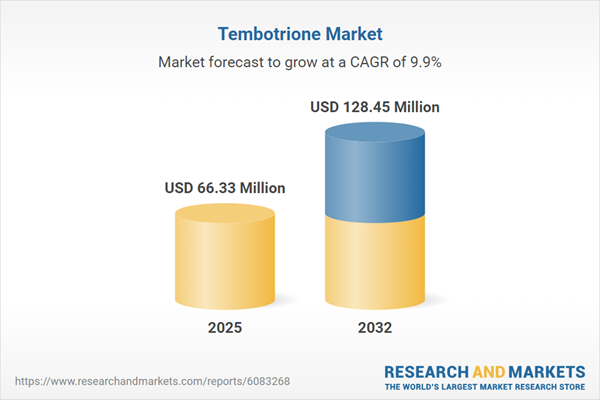Speak directly to the analyst to clarify any post sales queries you may have.
The Tembotrione market is rapidly evolving as agricultural producers seek innovative, sustainable solutions for effective weed management. This report equips senior decision-makers with critical insights on competitive positioning, regulatory shifts, and technology trends shaping the future of crop protection strategies.
Market Snapshot: Tembotrione Market Size, Growth, and Outlook
The global Tembotrione market increased from USD 60.28 million in 2024 to USD 66.33 million in 2025, reflecting a compound annual growth rate (CAGR) of 9.91%. The market is projected to reach USD 128.45 million by 2032. This upward trajectory is driven by a greater reliance on integrated weed management and advances in herbicide formulations that meet complex regulatory and operational demands. Evolving trade policies and the growing penetration of precision agriculture are opening new avenues for market development. Industry stakeholders gain increased opportunities to strengthen their competitive edge as adoption accelerates across both mature and emerging regions.
Scope & Segmentation
This report provides a systematic analysis of the Tembotrione market, with an emphasis on segmentation, drivers, and industry trends informed by ongoing research and market intelligence. A comprehensive view of structure and strategies is presented through the following lenses:
- Crop Types: Coverage spans key agricultural sectors including corn (field and sweet varieties), rice (both paddy and wild), soybean, and sugarcane. Segment-specific dynamics reflect Tembotrione’s importance as a tool for optimizing yield and protecting high-value staple crops.
- Formulation Variants: Examines options such as water dispersible granules, wettable granules, emulsifiable concentrates, and suspension concentrates. Ongoing advances in formulation technology enable improved user flexibility, safety, and operational efficiency.
- Application Timing: Considers early post-emergence, late post-emergence, and pre-emergence applications. These options allow for tailored weed control approaches, adapting deployment to seasonal and crop-specific requirements.
- Sales Channels: Evaluates access routes including direct sales, distributor operations, retailers, and agri-supplier outlets. A multi-channel approach enhances availability and aligns with diverse buyer profiles across markets.
- Regional Coverage: Profiles established and emerging markets across the Americas (including the US, Canada, Brazil), Europe, the Middle East, Africa (such as the UK, Germany, France, UAE, South Africa), and Asia-Pacific (with focus markets like China, India, Australia, Japan, and Southeast Asia). Each region presents distinct adoption pathways and regulatory dynamics.
- Key Companies Covered: Includes an assessment of principal suppliers such as Bayer CropScience AG, Corteva Inc., BASF SE, Syngenta AG, FMC Corporation, UPL Limited, Sumitomo Chemical Co., Ltd., Nufarm Limited, Adama Agricultural Solutions Ltd., and Mitsui Chemicals, Inc. Competitive strategies, innovation pipelines, and market presence are reviewed to support supplier evaluation.
Tembotrione Market: Key Takeaways for Leadership
- Herbicide resistance and heightened sustainability concerns are making Tembotrione essential in comprehensive weed management systems.
- Advancements in formulation and adoption of digital agriculture tools are promoting application precision, improving input use, and aiding compliance with evolving standards.
- Market segmentation by crop type, formulation, and timing is supporting strategic decision-making and operational alignment for greater efficiency and profitability.
- Collaboration between suppliers, distributors, and regulators is helping harmonize product safety and ensure wider market access.
- Accelerated uptake in Asia-Pacific and Latin America results from targeted regulatory frameworks and investments in agricultural modernization, driving growth in these emerging frontiers.
United States Tariffs: Impacts on Supply Chains and Market Structures
Anticipated tariff adjustments by US authorities in 2025 are increasing input costs, compelling manufacturers to reexamine supply chain strategies for Tembotrione. Market participants are adopting forward purchasing, forging regional partnerships, and renegotiating contracts to limit cost escalation and operational disruption. These shifts are influencing competitive positioning, particularly for companies with reliance on imports. Continuous assessment of trade policies will be essential to sustaining supply chain stability in the evolving regulatory context.
Methodology & Data Sources
Insights in this report are derived from in-depth qualitative interviews with agronomists, procurement specialists, and regulatory professionals, combined with current scientific publications, government resources, and comprehensive industry databases. Data quality is reinforced by triangulation and robust statistical validation.
Why This Report Matters
- Provides executive teams with actionable guidance rooted in emerging technology and integrated market shifts.
- Clarifies global regulatory landscapes, streamlining strategies for export, market entry, and product positioning.
- Enables senior decision-makers to anticipate industry challenges and pursue opportunities across regions and crop segments.
Conclusion
This report delivers the strategic intelligence senior executives need to respond decisively as the Tembotrione market advances. Informed analysis supports stronger positioning and agile adaptation to evolving regulatory and technological conditions.
Table of Contents
3. Executive Summary
4. Market Overview
7. Cumulative Impact of Artificial Intelligence 2025
Companies Mentioned
The companies profiled in this Tembotrione market report include:- Bayer CropScience AG
- Corteva, Inc.
- BASF SE
- Syngenta AG
- FMC Corporation
- UPL Limited
- Sumitomo Chemical Co., Ltd.
- Nufarm Limited
- Adama Agricultural Solutions Ltd.
- Mitsui Chemicals, Inc.
Table Information
| Report Attribute | Details |
|---|---|
| No. of Pages | 182 |
| Published | November 2025 |
| Forecast Period | 2025 - 2032 |
| Estimated Market Value ( USD | $ 66.33 Million |
| Forecasted Market Value ( USD | $ 128.45 Million |
| Compound Annual Growth Rate | 9.9% |
| Regions Covered | Global |
| No. of Companies Mentioned | 11 |









